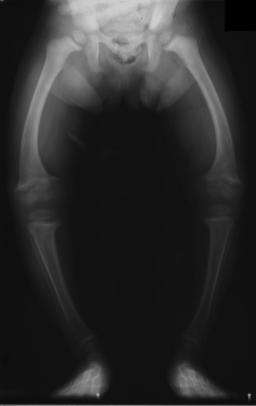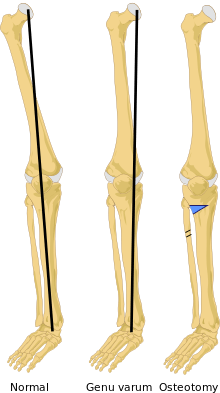Genu varum
| Genu varum | |
|---|---|
 | |
| X-Ray of the legs in a 2 year old child with rickets | |
| Classification and external resources | |
| Specialty | medical genetics |
| ICD-10 | Q68.3-Q68.5, Q74.1 |
| ICD-9-CM | 755.64 congenital; 736.42 acquired |
| DiseasesDB | 29404 |
| MedlinePlus | 001585 |
Genu varum (also called bow-leggedness, bandiness, bandy-leg, and tibia vara), is a physical deformity marked by (outward) bowing of the lower leg in relation to the thigh, giving the appearance of an archer's bow. Usually medial angulation of both femur and tibia is involved.
Causes
If a child is sickly, either with rickets or any other ailment that prevents ossification of the bones, or is improperly fed, the bowed condition may persist. Thus the chief cause of this deformity is rickets. Skeletal problems, infection, and tumors can also affect the growth of the leg, sometimes giving rise to a one-sided bow-leggedness. The remaining causes are occupational, especially among jockeys, and from physical trauma, the condition being very likely to supervene after accidents involving the condyles of the femur.[1]
Childhood
Children until the age of 3 to 4 have a degree of Genu Varum. The child sits with the soles of the feet facing one another; the tibia and femur are curved outwards; and, if the limbs are extended, although the ankles are in contact, there is a distinct space between the knee-joints. During the first year of life, a gradual change takes place. The knee-joints approach one another; the femur slopes downward and inward towards the knee joints; the tibia become straight; and the sole of the foot faces almost directly downwards.
While these changes are occurring, the bones, which at first consist principally of cartilage, are gradually becoming ossified. By the time a normal child begins to walk, the lower limbs are prepared, both by their general direction and by the rigidity of the bones which form them, to support the weight of the body.[1]
Blount's disease
Blount's disease is a deformity in the legs, mostly from the knees to the ankles. The affected bone curves in or out and forms the usual "archers bow" which can also be called bow-legs. There are two types of Blount's disease. The first type is Infantile: this means that children under four are diagnosed with this disease. Blount's disease in this age is very risky because sometimes it is not detected and it passes to the second type of Blount's disease. The second type of Blount's disease is found mostly in older children and in teenagers, sometimes in one leg and sometimes in both; the patient's age determines how severe the diagnosis is.[2]
Treatment

Generally, no treatment is required for idiopathic presentation as it is a normal anatomical variant in young children. Treatment is indicated when it persists beyond 3 and a half years old. In the case of unilateral presentation or progressive worsening of the curvature, when caused by rickets, the most important thing is to treat the constitutional disease, at the same time instructing the care-giver never to place the child on its feet. In many cases this is quite sufficient in itself to effect a cure, but matters can be hastened somewhat by applying splints. When the deformity arises in older patients, either from trauma or occupation, the only permanent treatment is surgery, but orthopaedic bracing can provide relief.
Blount's disease
Treatment for children with Blount's disease is typically braces but surgery may also be necessary, especially for teenagers. The operation consists of removing a piece of tibia, breaking the fibula and straightening out the bone; there is also a choice of elongating the legs. If not treated early enough, the condition worsens quickly.[3]
Prognosis
In most cases persisting after childhood, there is little or no effect on the ability to walk. Due to uneven stress and wear on the knees, however, even milder manifestations can see an accelerated onset of arthritis. Those with bowlegs and a genetic predisposition for developing arthritis will likely start having arthritic symptoms around age 30.
See also
References
- 1 2
 One or more of the preceding sentences incorporates text from a publication now in the public domain: Chisholm, Hugh, ed. (1911). "Bow-Leg". Encyclopædia Britannica. 4 (11th ed.). Cambridge University Press. pp. 343–344.
One or more of the preceding sentences incorporates text from a publication now in the public domain: Chisholm, Hugh, ed. (1911). "Bow-Leg". Encyclopædia Britannica. 4 (11th ed.). Cambridge University Press. pp. 343–344. - ↑ Shriner's, Hospital for Children – Houston, TX. "Blount's Disease". Retrieved October 28, 2011.
- ↑ PubMed, Health. "Blount's Disease". Retrieved October 28, 2011.
External links
- "Bowed Legs". American Academy of Orthopaedic Surgeons.
Reviewed by members of POSNA (Pediatric Orthopaedic Society of North America)